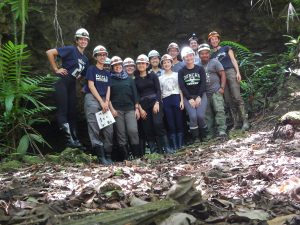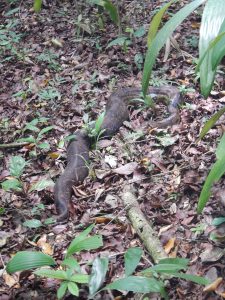I woke up to people commanding me to pee inside a tube. “50 mills in two tubes” they said. I beat everyone else’s pee in coloration, which I like to think may be indication I have the highest concentration of nitrogen in my urine. And that’s relevant because, Scott tells us, one of the crucial limiting nutrients of the the canopy in tropical rain forests. After about an hour of questions, discussion, and writing in our field notebooks, we narrowed in on what exactly this urine experiment was going to be.
General question: How does different levels of limiting nutrients, such as nitrogen, affect insect biodiversity.
Context: In nutrient-poor soils of the tropical rainforests, nitrogen is often a limiting factor of life. It is more limiting in the canopy.
Main Hypothesis: The species richness in urine traps of canopy will be higher than water traps of canopy. This differential is greater than the same type of differential found in the forest floor, suggesting that nitrogen is more of a limiting nutrient in the canopy than in the forest floor.
After 2 days, we will collect our traps and count the numbers of the insect species we have captured.
For more on our project, please check a later blog post, which will contain our findings.
Also, today I found a bee hive outside of the dining room, with many yellow-abdomen bees coming out. They had all the similar morphological traits of a bee I had on my taxon identification card, but these had white front feet. I will have to look through more identification literature to see which species this is.

The other half of our daytime was dedicated to something that better resembled the night. Walking in complete darkness during our first cave exploration. Las Cuevas (spanish for ‘the caves’) caves, are unlit karst formations that resulted from acidic water cutting through limestone. After many years, a whole underground network of life has formed, including the fertilizing bats who power the cave ecosystem through their feces and the accidental venturers who decay inside after failing to find a way out. Guano, truly, is a a glorified name for bat shit. You know, when people say, “that’s some crazy bat shit”… Well, it turns out that a whole ecosystem inside of the Las Cuevas caves (and many other caves around wthe world) depend on guano, both those of bats, and those from crickets. Cave millipedes ingest and digest guano and without it would not be able to survive. I would like to say more, but the fact on the matter is that we do not konw enough. Life there has been unidentified to a large degree, comparable to the deep sea or even extraterrestial life.
Currently, many explorers in these caves are people who are daring and willing to take on the complete darkness and the scary unknowns that come with being in caves. We were told by Raphael, leader of the Friends of Conservation and Development (NGO in Belize), that “we know that each time someone goes into the cave they find a new species”. At the very least, someone ought to write a post-apocalyptic novel revolving around life in the caves. One of the last things we did in the caves was to use guano mud to write and draw on the cave wall. Having heard stories about the Mayan demise, it makes me wonder, when it comes to cave art, how much we, as a species, has evolved in leaving behind markers of our existence and what, if any, meaning can be derived from our symbolic representation after our species has either evolved or died out.

